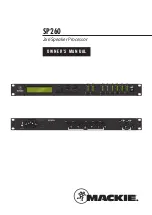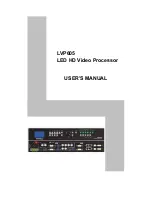
Description of the Subsystem
40
SPRUHI7A – December 2012 – Revised June 2016
Copyright © 2012–2016, Texas Instruments Incorporated
High-Definition Video Processing Subsystem (HDVPSS)
1.1.5 HDVPSS Data Flow
1.1.5.1
Data Flow Control
The VPDMA routes input and output video sources to the starting or ending point of each processing
pipeline.
Signal routing within the HDVPSS is controlled by an internal protocol referred to as Video Peripheral
Protocol (VPI Protocol). This protocol consists of a NewFrame (NF) signal at the start of each frame which
indicates to downstream modules that a frame of data is about to start. On the last signal of a frame, an
EndofFrame signal is sent to indicate the last pixel of a frame. In addition to preparing downstream
modules for frames of data, the NewFrame signal is used in many modules to stage the memory mapped
registers. Each processing module will receive a NewFrame signal, and will generate a NewFrame signal
to send to its downstream module. Sections in the register section which refer to New Frame, or NF
handling, refer to this signal.
Internal Control is accomplished by configuring the selection of data paths available at the input of each of
the multiplexers (see
). This configuration can be done in the CLKC Data Path Select Register.
This register controls where internal processing pipes are connected.
1.1.5.2
VCOMP Mux
The video compositor (VCOMP) module takes two inputs: MAIN and PIP. The MAIN input comes from
Primary Input Path, and PIP input can be selected from one of three sources: Auxiliary Input Path (AUX),
Bypass Path0 (BP0), or Bypass Path1 (BP1). The default for the PIP path is disabled, so there is no PIP
input unless it is configured.
1.1.5.3
HD Display Mux
The HD display mux selects a data path for HD displays, which include HDMI/DVO1, and DVO2 outputs.
The input data path can be selected from three sources: Auxiliary Input Path (AUX), Bypass Path0 (BP0),
or Bypass Path1 (BP1). The default for the input data path is disabled, so no input path is selected unless
it is configured.
1.1.5.4
SD Display Mux
The SD display mux selects a data path for SD display that includes SDVENC output. The input data path
can be selected from one of four sources: Auxiliary Input Path (AUX), Bypass Path0 (BP0), Bypass Path1
(BP1), or Secondary-1 Input Path (SEC1). The default for the input data path is disabled, so no SDVENC
input path is selected unless it is configured.
1.1.5.5
SC_5 Mux
The SC_5 mux selects a data path for writing a processed image back to memory. The input data path for
this MUX can be selected from one of six sources:
•
HDMI Composited Path Output (from COMP)
•
VCOMP Block Output
•
Bypass Path0 (BP0)
•
Bypass Path1 (BP1)
•
Secondary-0 Input Path (SEC0)
The default for the input data path is disabled, so there is no scaler input or output.
1.1.5.6
CSC_VIP Mux
The color space converters (CSC_VIP0 and CSC_VIP1) within the VIP subsystem receive data from one
of five sources:
•
VIP_PARSER PortA Output (422)
•
VIP_PARSER PortB Output (422)
















































